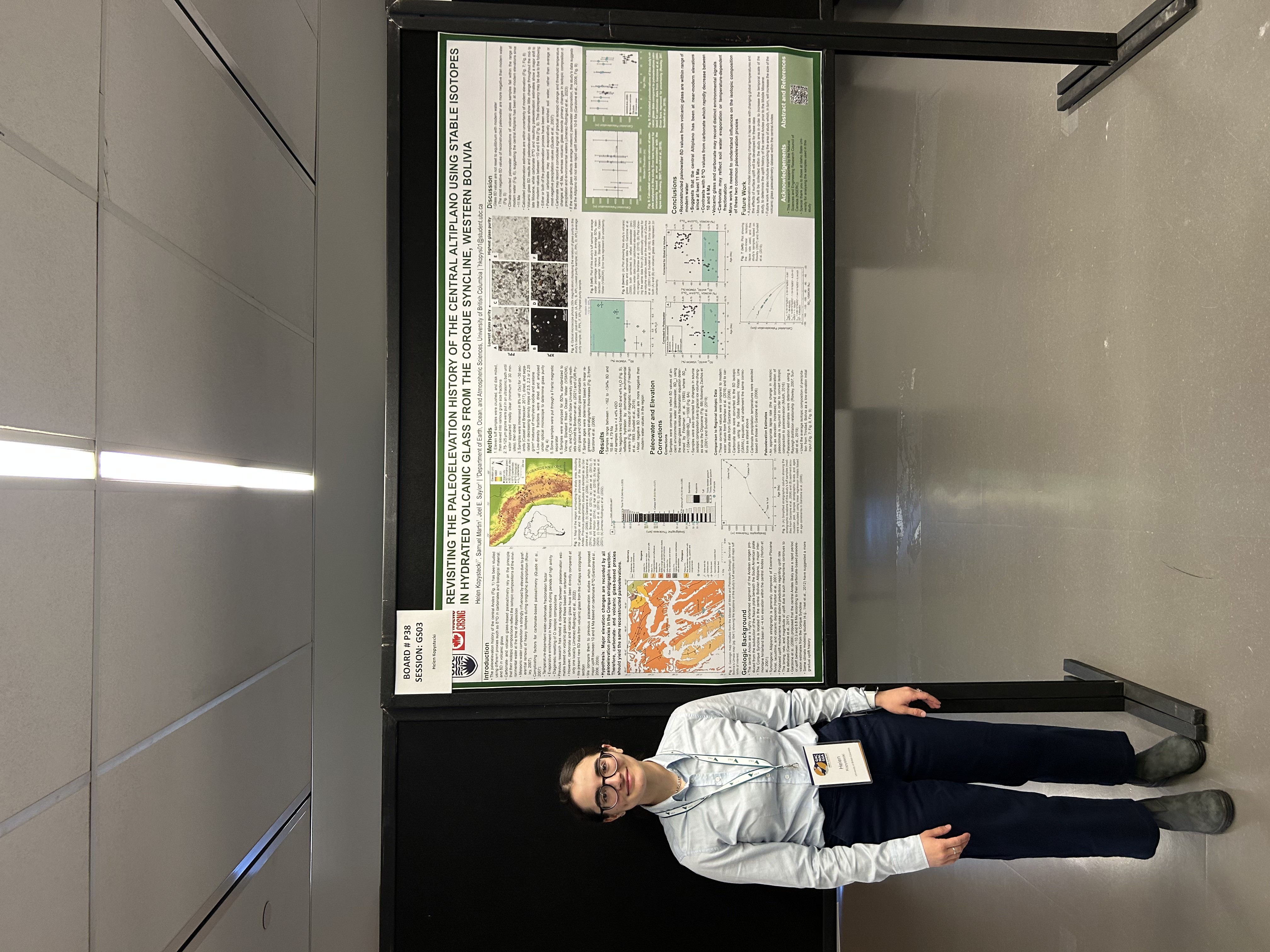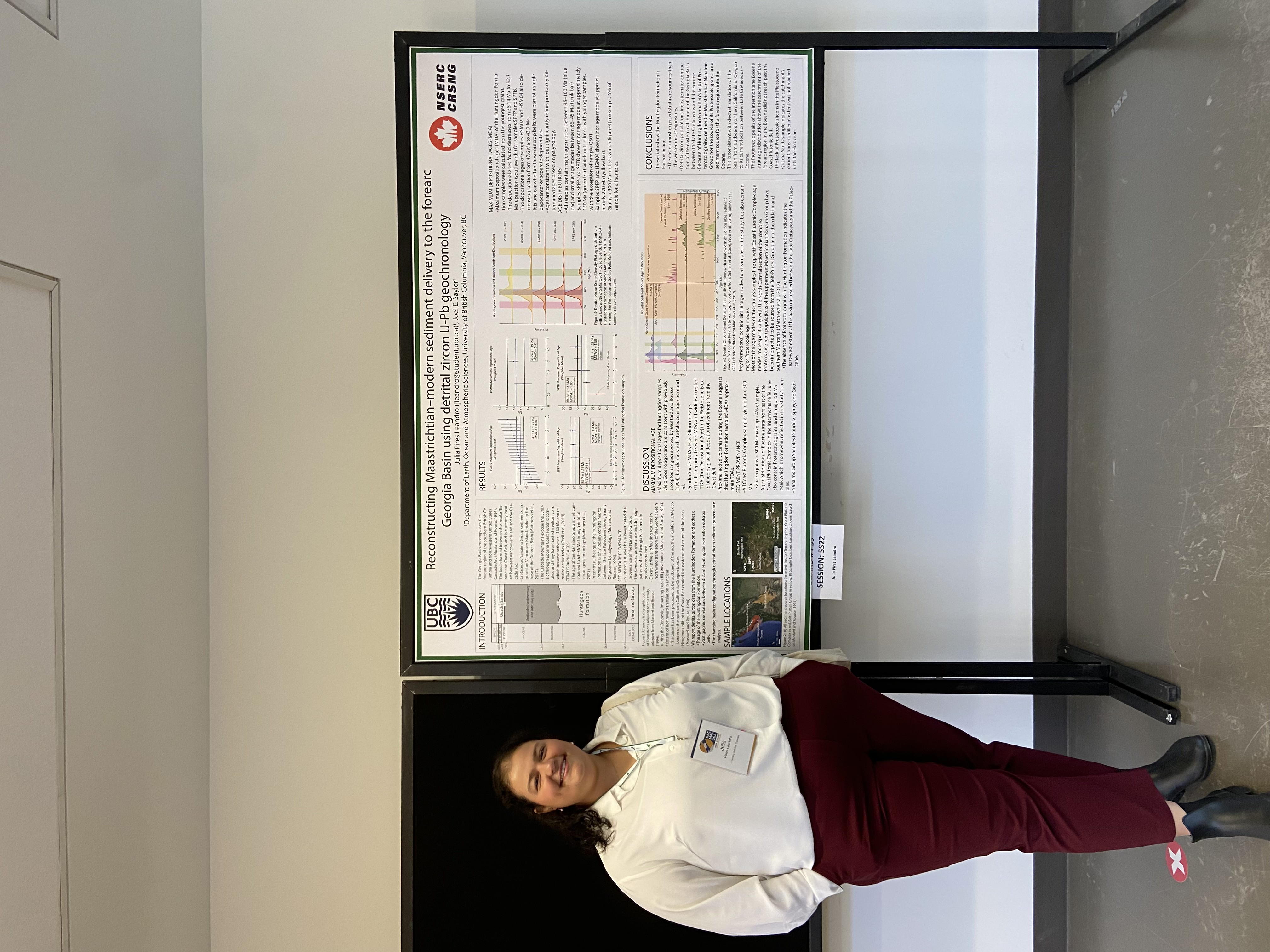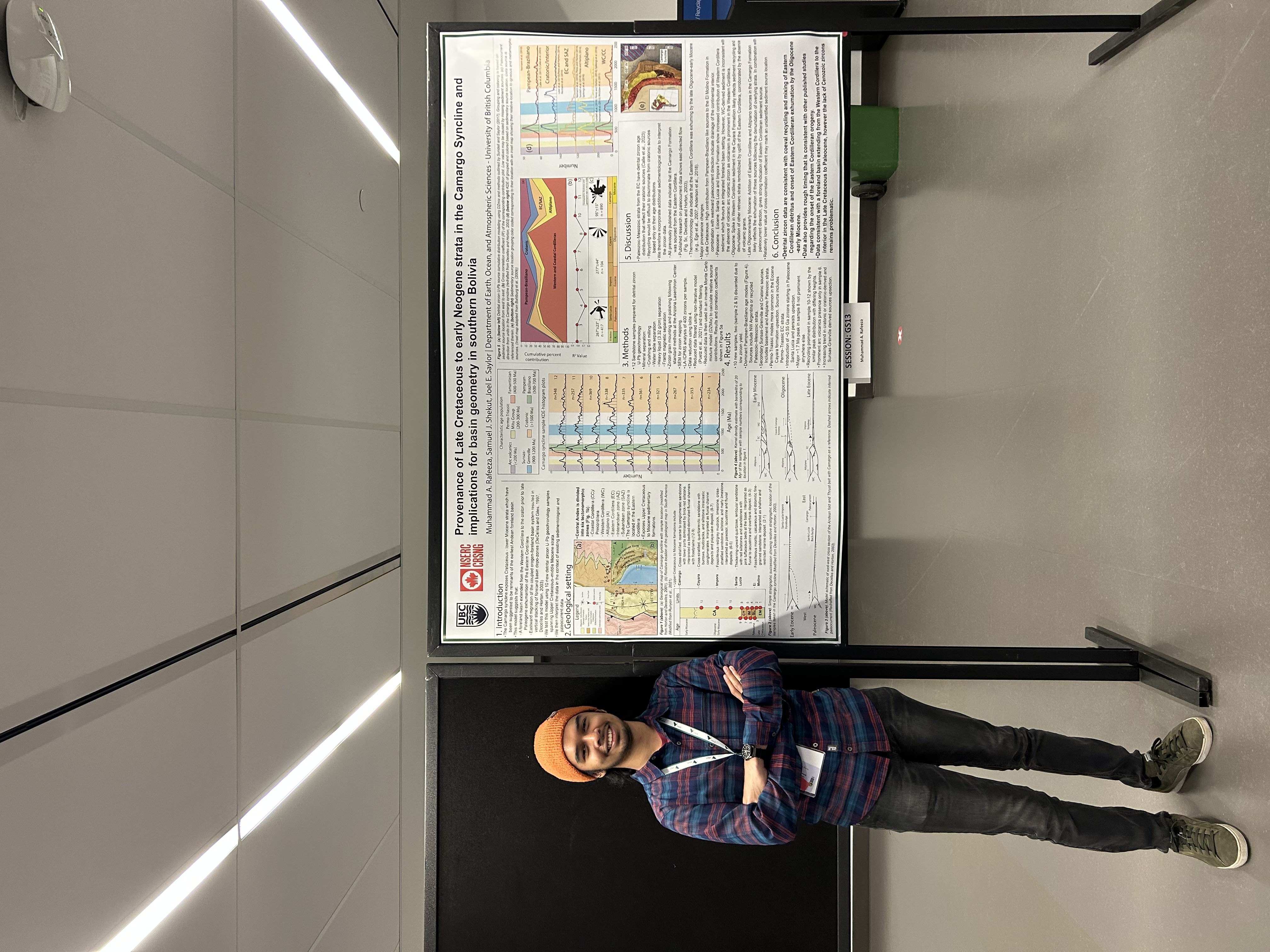News
Stay up-to-date with what's happening in EOAS
Unraveling Earth's Secrets: EOAS Undergrads Present New Discoveries from Bolivian Andes and Vancouver Basin
Three EOAS undergraduate students attended the Joint Annual Meeting of the Geological Association of Canada, Mineralogical Association of Canada, and Society for Geology Applied to Mineral Deposits (GAC-MAC-SGA) in Sudbury, Ontario in the past week to present original research that they conducted with graduate students and faculty at UBC.
Helen Kopystecki's presentation, entitled, "Revisiting the paleoelevation history of the central Altiplano using stable isotopes in hydrated volcanic glass from the Corque Syncline, western Bolivia", builds on her 1.5-month field work in Bolivia in 2022. Her results call into question a long-standing paradigm that the Andes were rapidly uplifted in the late Miocene. They hypothesized that since major elevation changes are recorded by all paleoelevation proxies in the Corque stratigraphic section, carbonate- and volcanic glass-based proxies should yield the same reconstructed paleoelevations. However, their data indicated that volcanic glass and carbonate may record distinct environmental signals: reconstructed paleowater δD values from volcanic glass suggests that the central Altiplano has been at near modern elevations since at least 11 Ma, contrasting with δ18O values from carbonate rapidly decrease between 10 and 6 Ma. They suggested that more work is needed to understand influences on the isotopic composition of these two common paleoelevation proxies.

Helen Kopystecki
Julia Leandro's presentation entitled, "Reconstructing Maastrichtian–modern sediment delivery to the forearc Georgia Basin using detrital zircon U-Pb geochronology" includes the results of detrital zircon geochronology from the Huntingdon Formation in southern BC. Her results provide the first absolute ages for the Huntingdon Formation near urban Vancouver. Her data showed that Huntingdon Formation is Eocene in age and that major contraction of the eastern catchment of the Georgia Basin happened between the Late Cretaceous and the Eocene. Because of Huntingdon Formation’s lack of Proterozoic grains, neither the Maastrichtian Nanaimo Group nor the source of its Proterozoic grains are a sediment source for the forearc region into the Eocene. Their data also showed that the catchment of the forearc region in the Eocene did not reach past the Coast Plutonic Belt and that the catchment’s current trans-cordilleran extent was not reached until the Holocene.

Julia Leandro
Muhammad Rafeeza presented new detrital zircon geochronology from Bolivia in his poster entitled, "Provenance of Late Cretaceous to early Neogene strata in the Camargo Syncline and implications for basin geometry in southern Bolivia," which also builds on field work in South America. His results provide confirmatory data for the existing geodynamic model while at the same time calling into question source-to-sink (fluvial) relationships between the magmatic arc and the retroarc foreland. Their detrital zircon data is consistent with coeval recycling and mixing of Eastern Cordilleran detritus and onset of Eastern Cordilleran exhumation by the Oligocene-early Miocene. Their data also provides rough timing consistent with other published studies regarding the onset of the Eastern Cordilleran orogeny and is consistent with a foreland basin extending from the Western Cordillera to the interior in the Late Cretaceous to Paleocene.

Muhammad Rafeeza
Explore Your World, Inspire Change: Unlock Your Future as an Earth Scientist!
Get ready to embark on an extraordinary journey into the intricacies of our planet. Our courses and degree programs not only impart knowledge but also ignite inspiration and empower change-makers. As you delve into the phenomena that shape planet Earth, you'll cultivate critical thinking and problem-solving skills, essential tools for tackling today's most pressing environmental challenges, such as climate change and sustainable resource use.
We believe in fostering a connection between our students and the various sectors of society, including industry professionals and policymakers. This not only offers you a well-rounded perspective of our planet's challenges but also equips you with the practical understanding needed to make a tangible impact.
But our commitment to your education doesn't stop there. We provide practical tools, experiential learning, and access to cutting-edge research opportunities to fully prepare you to protect and sustain our planet. We're more than an academic department; we're a community of dedicated innovators and explorers passionate about making a difference.
So, if you're ready to step out of the textbook and into the real world, we want you to join us. It's not just about earning a degree; it's about becoming an environmental steward and shaping a better future for us all. Your journey toward transforming the world starts here!
Professor Rachel White on CBC's Planet Wonder: All about the jet stream
Within the past few years, Vancouverites have experienced more intense and frequent extreme weather events. Two summers ago, BC was hit with a catastrophic heat wave, which was followed by a series of atmospheric rivers in the Fall of 2021. Many of us remember the scorching heat and the highway closures due to flooding, but how do these weather extremes develop?
During an interview for CBC's Planet Wonder series, Dept. of Earth Oceans and Atmospheric Sciences professor, Dr. Rachel White recently explained how such weather events are formed and carried by the atmosphere’s jet streams. While standing in the Pitt River, Dr. White used her surroundings to describe the jet stream, comparing storm systems to the eddies created in the meandering river. The series host and CBC meteorologist, Johanna Wagstaffe, used further visual aids including a turntable and water bath to explain how temperature gradients between the poles and the equator on our spinning planet act to create the jet stream. By the end of the 25 minute episode, viewers are walked through 1. How the jet stream is formed, 2. How it creates extreme weather events felt on Earth’s surface, and 3. How climate change is impacting the jet stream. To watch Rachel White’s feature head to Season 1, Episode 7 ‘What’s going on up there to make weather down here so extreme’.
EOAS Climate Myth Busters
We are excited to announce that our newest video series, Climate Myth Busters, is live now! This series showcases brief, 1-minute videos featuring EOAS graduate students and faculty debunking widespread misconceptions about Earth's climate. We are excited to share this content with the public, sparking meaningful conversations around climate science. Watch the videos on Youtube or on our Climate Crisis page.
Climate myth busted #1: Climate change is real but its too late to do anything about it
Xueya Lu, Ph.D. student
Climate myth busted #2: Climate models are unreliable and predicting future climate is impossible
Eva Gnegy, Ph.D. student
Climate myth busted #3: There is no difference between weather and climate
Dr. Rachel White, Assistant Professor
Climate myth busted #4: Climate changes of the likes we are experiencing is part of a natural cycle
Ruth Moore, Master's student
Dr. Catherine Johnson has been elected to the National Academy of Sciences
Dr. Catherine Johnson, Professor in the Department of Earth, Ocean and Atmospheric Sciences, has been elected to the National Academy of Sciences. Dr, Johnson is among 120 new members and 23 international members elected this week, and she joins five other UBC Science researchers as a member of the Academy. The National Academy of Sciences is a private, non-profit institution that was established under a congressional charter signed by President Abraham Lincoln in 1863. It recognizes achievement in science by election to membership, and—with the National Academy of Engineering and the National Academy of Medicine—provides science, engineering, and health policy advice to the federal government and other organizations. Members are elected to the NAS in recognition of their distinguished and continuing achievements in original research. Membership is a widely accepted mark of excellence in science and is considered one of the highest honors that a scientist can receive.
Dr. Johnson uses observatory and satellite data to probe the interior structure and history of terrestrial planets, moons and small bodies in our solar system. She has been a co-investigator on several NASA planetary missions. Recent work by Dr. Johnson has delved into the geological characteristics of Mars and Earth’s moon. The research indicates Mars had a global magnetic field much earlier—and much later—in the planet's history than scientists have previously known. Her work with researchers at the Smithsonian using Apollo mission seismic data shows that some shallow moonquakes can be linked to young faults—evidence that the moon, like Earth, is tectonically active.
Read more:
Five UBC Science researchers join Royal Society of Canada
UBC Science: UBC planetary scientist elected to U.S. National Academy of Sciences
National Academy of Sciences Elects Members and International Members
Dr. Catherine Johnson elected as a member of the American Academy of Arts & Sciences
Professor Catherine Johnson Awarded Killam Research Prize
Call for Logo Designs 2023
The Department of Earth, Ocean and Atmospheric Sciences (EOAS) at the University of British Columbia (UBC) is excited to announce a call for submissions to a Logo Design competition. We are looking for a creative and striking logo that reflects the values of our department, and showcases our commitment to advancing research, education and public engagement in the domain of Earth, Ocean and Atmospheric Sciences.
EOAS is the largest and most diverse department of its kind in Canada, and is recognized as a global leader in Earth Ocean and Atmospheric Sciences. Over the past quarter century, we have worked to realize a vision of interdisciplinary collaboration, tackling complex Earth Sciences research questions. Moving forward, we will continue to implement this vision through high-impact research and teaching, and through public engagement and outreach. We aim to advance our scientific understanding of the Earth System and use this information to guide societal actions towards improved stewardship of Earth’s resources.
The winner of the competition will receive a $500 cash prize and have the opportunity to collaborate with UBC EOAS to refine the logo further.
Eligibility
Participants should be undergraduate or graduate students at UBC or a university program in graphic design, digital media or equivalent.
Requirements and Criteria
-
We are mainly looking for a monochrome logo, but also open to duo-coloured options. In the case where color is used, the logo should include the primary color of UBC EOAS (#096261), and may also optionally use the secondary colors (#E2EBEB and #1B1C1E) Dimensions of the logo should be 400 pixels x 400 pixels (minimum 72 DPI).
-
The logo should be useful for print, website, and social media applications.
-
The logo should reflect the multidisciplinary nature of EOAS, communicate our dedication to Earth, Ocean and Atmospheric Sciences, and reflect the interactions between different elements of the Earth System.
Submission and Selection
-
Please submit the logo in high-quality image format to: comms@eoas.ubc.ca with the email subject line: “EOAS Logo Submission - YOUR NAME - YOUR FIELD OF STUDY - YOUR SCHOOL”.
-
Please feel free to write an art statement or explanation for your logo submission.
-
A committee of faculty, staff, and students representing EOAS will serve as the selection committee.
Deadline for Submissions
June 15, 2023
Terms & Conditions
-
Upon selection, the winning participant agrees to transfer all ownership and intellectual property rights of their submitted logo design to UBC EOAS. This transfer enables the organization to freely use and modify the logo without further permission or compensation.
-
UBC EOAS reserves the right to modify the winning logo and may collaborate with the winning participant for further refinements as deemed necessary.
-
Participants confirm that their submissions are original and do not infringe upon any intellectual property or other rights of any third party.
-
Participants acknowledge that UBC EOAS may utilize the winning design for promotional purposes, including but not limited to, featuring the design on its website, social media accounts, and promotional materials.
-
The winning submission is not guaranteed to be officially adopted by UBC EOAS. UBC EOAS reserves the right to choose an alternative design or refrain from using any submitted designs.
-
By submitting a logo design, participants agree to comply with these rules and any additional terms and conditions imposed by UBC EOAS.
Contact
For more information, please contact comms@eoas.ubc.ca.
More about UBC EOAS:
Website: https://www.eoas.ubc.ca/
Facebook: https://www.facebook.com/ubceoas/
Instagram: https://www.instagram.com/ubceoas/
YouTube: https://www.youtube.com/@ubceoas
Twitter: https://twitter.com/UBCeoas





